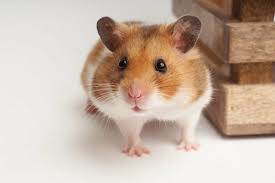
Syrian hamster
Conditions of detention
Syrian hamsters require a spacious cage with a solid base. The cage should have plenty of space for burrowing, climbing, and nesting, with a secure lid to prevent escapes.
Useful Fact: They are solitary animals and should always be housed alone to prevent fighting.
Nutrition and diet
A balanced diet for Syrian hamsters includes high-quality hamster pellets, fresh vegetables, occasional fruits, and protein sources like boiled eggs or mealworms.
Useful Fact: Fresh water should be provided daily, and foods like garlic, onions, and chocolate should be strictly avoided as they are toxic.
Health
Prone to respiratory infections, wet tail (a severe bacterial infection), and dental issues due to overgrown teeth.
Useful Fact: Regularly inspect their teeth and nails to ensure they do not become overgrown, which can lead to discomfort and health problems.
Grooming and care
Syrian hamsters usually keep themselves clean, but long-haired varieties may need brushing to prevent matting. The cage should be cleaned weekly to avoid ammonia build-up from urine.
Useful Fact: Sand baths can be provided occasionally to help with grooming, but water baths should be avoided as they can stress the hamster and cause hypothermia.
Education and training
Syrian hamsters can be tamed and become hand-friendly with gentle, regular handling. Start with short sessions to build trust.
Useful Fact: They do not respond well to traditional training but can learn to come to their owner’s hand for food.
Toys and entertainment
These hamsters enjoy running wheels, tunnels, chew toys, and climbing structures.
Useful Fact: A wheel with a solid surface is important to prevent injuries, as wire wheels can cause foot problems.
Safety
Keep the environment free from small objects they might swallow, and ensure the cage is escape-proof.
Useful Fact: Syrian hamsters are nocturnal and may be more active and noisy at night, so placing their cage in a quiet area where they won’t be disturbed during the day is recommended.
Accessories
A solid exercise wheel, hideouts, chew toys, and a water bottle.
Useful Fact: Provide different textures and materials like wood, cardboard, and hay to stimulate their natural chewing instincts.
Socialization
Syrians are solitary and do not need the company of other hamsters. They may become aggressive if housed with others.
Useful Fact: Socialization with humans is essential; handle them daily to keep them tame and accustomed to human interaction.
Travel and Transportation
Use a secure, well-ventilated carrier for transportation. Make sure it’s escape-proof and lined with familiar bedding.
Useful Fact: Keep travel times short and avoid exposing them to extreme temperatures or drafts during transit.
Behavior and psychology
Generally friendly and curious when well-handled, but they can be territorial and may bite if startled or threatened.
Useful Fact: Understanding their nocturnal nature can help in preventing stress and behavior issues; they should be allowed to sleep undisturbed during the day.
Legal aspects
In most places, owning a Syrian hamster is legal, but it’s important to check local regulations, especially if you plan to breed them.
Useful Fact: Always purchase from reputable breeders or pet stores to avoid issues with illegal or inhumane breeding practices.


